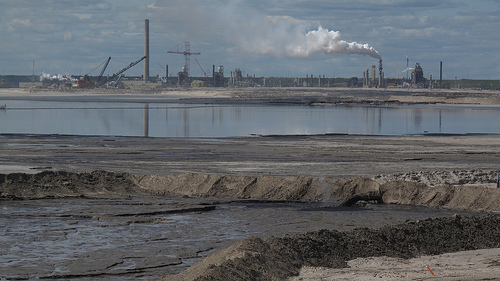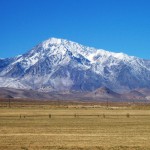
A tar sands refinery. Photo credit: the Pembina Institute
There’s been a lot of discussion in the last few years about the Keystone Pipeline, a network of pipelines being built to transport oil from Canada to the United States. President Obama has gotten hit from both sides: some have criticised him for slowing down a valuable source of energy for the U.S. Others have slammed him for moving forward with a plan that will cause environmental destruction and speed global warming.
The environmentalists are not just upset over damage caused by building the pipeline. They’re worried about what’s flowing through it, too. The oil isn’t your average black gold: it comes from vast deposits of tar sands across Alberta, Canada. Confused about how that’s different from a Texas oil well? Read on.
What are tar sands?
Tar sands are mixtures of sand, water, clay, and a thick form of petroleum called bitumen. Bitumen is classified as a “heavy oil,” because it sinks in water. It can be processed into gasoline, diesel, plastic, and other petroleum products.
There are huge deposits in Canada – the third largest proven oil reserve in the world, after Saudi Arabia and Venezuela. There are reserves elsewhere, including Russia and the U.S., but Canada is the only place with a major commercial mining operation right now.
Are they anything like oil sands?
Same thing. It’s like the pro-life/pro-choice debate – people who are in favor of mining tar sands think the word “tar” is negative spin.
How do you get to the bitumen?
70% is in Alberta, a province in northwestern Canada, where it’s so cold the sands are frozen solid. There are two main ways to access the bitumen. The sands can be strip-mined, tearing up the forest and soil above them and then digging out the sand with backhoes the size of houses. Other reserves are too deep, so the tar is melted with solvents, hot water, or steam and sucked up through a pipe. Heating the water means burning a lot of fuel, whether it’s coal or natural gas. So just getting the oil out of the ground has a serious carbon footprint. It takes about two tons of sand to produce one barrel – 42 gallons – of oil.
What happens to the water?
Depending on who you ask and which process you’re talking about, it takes between two and twelve barrels of water to get one barrel of bitumen. Much of that gets recycled for reuse, but some portion is wasted on each cycle. According to the Canadian government, between 40 and 90 percent of the water is recycled.
Utah, which has an estimated 12 to 19 billion barrels of oil tied up in tar sands, has just issued a permit for a Canadian company, US Oil Sands, to begin mining. The company says it will use two barrels of water for each barrel of oil, and that 85% will be recovered. 15% loss might not seem like much, but Utah is in the middle of a drought – the company had to dig 2,000 feet into the earth to find enough water for a test mine.
So what do you do once you have the bitumen?
The bitumen is separated from the sand and clay, usually by mixing it with lye and hot water to melt it and push it to the surface, riding on tiny bubbles. This is called “frothing.” Once the bitumen is skimmed off the top, it is processed with heat, pressure, and chemicals into synthetic crude oil. From there it can be used like regular crude, including turning it into gas and diesel.
What happens to all the other junk?
It gets pumped into what are affectionately called “tailings ponds.” They’re actually enormous, artificial lakes full of toxic waste, including residual bitumen, solvents, and heavy metals like arsenic and mercury, which are naturally found in tar sands. Occasionally ducks land on the ponds, become coated in oil, and die.
Oil companies claim that the lakes are lined well enough for the waste to be safely contained. They also have equipment meant to detect any leaks and pump the liquid back into the lakes, but several studies have shown that the waste leaks into the water supply. Models suggest a single pond might leak as much as 6.5 million liters every day. Tar sand mines across Canada produce around 250 million liters of waste in a day. Overall, the tailings ponds cover 176 square kilometers, a little less than the area of Brooklyn.
Ew. Do tailings ponds just sit around forever?
No, eventually they dry out. Petroleum companies have promised to “reclaim” the land, replacing the topsoil and planting native species. The first reclamation began in 2010. It is unclear if the land will ever return to its original state.
Let’s talk about greenhouse gases.
OK. So tar sands are one of the most energy-intensive sources of fossil fuel. Compared to other oil the U.S. imports, tar sands oil releases 14 to 20 percent more carbon between mining and use.
Besides the fuel needed to heat the water, the bitumen has to be processed to make it usable. After you get it out of the sand, you have to turn it into “synthetic crude,” which is more easily manipulated than the asphalt-like bitumen. Either near the mines in Canada or in the refineries on the other ends of pipelines, the bitumen is “cracked,” its long molecular chains of carbon and hydrogen broken into shorter molecules.
The process also creates coke, a black carbon product similar to coal. Coke is almost pure carbon. When it is burned, it releases 30 percent more CO2 than coal, but these greenhouse gas emissions are not counted in industry estimates of the carbon cost of tar sands.
The United Nations has determined that, to avoid the most damaging effects of climate change, the global temperature should not increase more than 2 degrees Celsius. Some scientists say the cut-off for that increase is one trillion tons of carbon released into the atmosphere. If all the bitumen in oil sands could be burned, it would release 240 billion tons of carbon into the atmosphere. If we just burned the bitumen we can currently access, it would add 22 billion tons of carbon. Humans have already added 577 billion tons since the industrial revolution.
Who buys oil from tar sands?
You probably do! The U.S. gets 28% of its oil from Canada, more than it imports from any other country. Over half of that comes from tar sands. China has also bought stakes in several Canadian mining projects. As for Europe, it depends. Demand might go down, if the E.U. designates tar sands oil as “highly polluting.” Otherwise, demand might actually increase.
What does all this have to do with the Keystone Pipeline?
The Keystone Pipeline is a system of oil pipelines owned by TransCanada, a Canadian energy company. The lines go from the biggest oil sands mines in Alberta, Canada, to various refineries and marketplaces in the U.S. They transport synthetic crude, as well as “dilbit” – bitumen diluted with natural gas to make it flow. Several legs of the pipeline are already in use, traveling from Canada to Texas, with stops in Illinois and Oklahoma.
An extension, known as Keystone XL, has been the subject of enormous controversy. The southern half, from Oklahoma to Texas, began pumping American oil on January 21, 2014. The northern section, which hasn’t been approved yet, would go from Canada to Nebraska. It would travel through ecologically sensitive areas, which means a leak could be disastrous. Leaks are a big risk – there have been five major oil pipeline leaks in America since 2010.
It would also travel over a major aquifer in Nebraska. The original plans called for the pipeline to travel through wetlands, the Sandhills, but under pressure from environmental groups President Obama rejected the plan. TransCanada agreed to change the route, avoiding the wetlands. President Obama hasn’t yet decided whether to approve the updated application.
If that leg of the pipeline isn’t built, will Canada stop mining tar sands?
No. There’s a huge demand for the oil, not just from the U.S., but from overseas. Asian countries, including China, are more than happy to import tar sands oil. In addition, without the pipeline, Canada can transport the bitumen and synthetic crude here in oil tankers or on trains, either of which are more energy intensive than a pipeline.
The State Department released its final environmental impact study a month ago, saying that building the pipeline would not have a significant effect on carbon emissions. That’s not because mining tar sands isn’t bad for the environment – it’s because the sands will be mined, regardless if the pipeline is built.
What’s the take-home?
Tar sands are an easy way for the U.S. to get oil from a friendly neighbor. They’re also a massive source of fossil fuels. They have a serious environmental impact during mining, might have one during transportation, and burning all of them could kick us into the red zone for global warming. But across the world, demand for petroleum continues to grow, and tar sand mining will continue to grow with it.







Comments are closed.